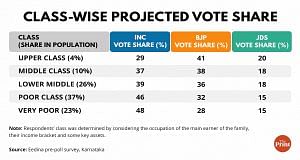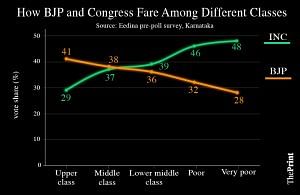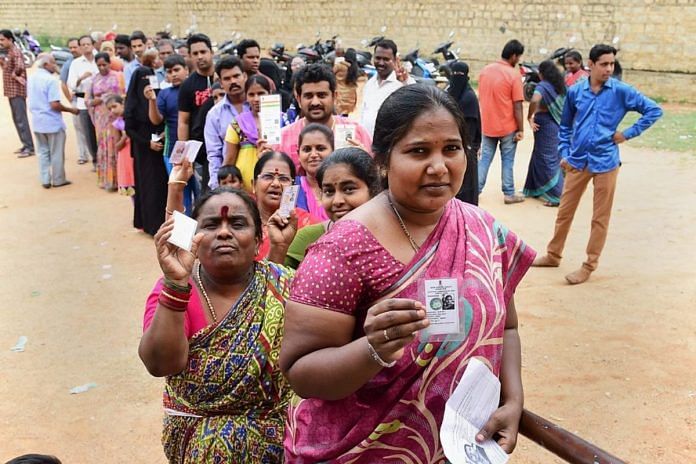One day, I wish to write an article to persuade my Marxist friends to take class analysis seriously. This joke, which I often crack at the expense of my Left and ex-Left friends, points to something deeper. Political analysts in India have swung like a pendulum; from the days when, under Marxist influence, they detected class struggle in every cockfight to these days when they see nothing except caste. The joke also conceals guilt: people like me may have contributed to this degeneration by presenting data on caste and voting for the first time on television.
The upcoming Karnataka election has reminded me of this old joke. It has also offered me an opportunity to present a glimpse of what I wanted to say in the article that I never wrote. Class matters. It matters more than what we care to notice or admit.
It began with my meeting with Eedina, a group of activists who set out to create an alternative peoples’ media in Kannada. They have carried out a large pre-poll survey across the state. Now, I have done and seen far too many election surveys to get excited about one more survey. What interested me in this exercise by Eedina was its public character. Instead of hiring paid professionals from a polling agency (there are just too many of them these days, mostly sub-standard), the Eedina group engaged nearly 1,000 citizen journalists that they have trained. These volunteers went to 204 out of 224 assembly constituencies in Karnataka and carried out face-to-face interviews (instead of the cheap telephonic ones that have become common these days) with 41,169 respondents. Their sampling was fairly rigorous (random selection of booths and random selection of respondents from the voters’ list of the sampled booth). The sample profile is a fair representation of the demographic profile of Karnataka. So the survey researcher in me had good reasons to take their findings seriously. [Disclosure: I gave technical advice on the survey design and was given access to its data files.]
For the record, the Eedina survey predicts a Congress wave in the Karnataka election, which will be held on 10 May and the results will be out on 13 May. Unlike other surveys that show a slender edge for the Congress in a hung assembly, the Eedina survey projects a comfortable majority of 132-140 seats for the Congress in the 224-member assembly, the party’s best tally in the last three decades. The ruling Bharatiya Janata Party (BJP) is expected to shrink to just 57-65 seats and the ‘kingmaker’ hopeful Janata Dal (Secular) to just 19-25 seats. This projection is based on the survey estimate of a whopping 10 percentage points gap in vote share: 43 per cent for Congress (up 5 per cent from 2018), 33 per cent for the BJP (down 3 per cent), and 16 per cent for the JDS (down 2 per cent).
Also read:
Textbook model of class voting
While I have no reason to disbelieve their election projection – it’s true to their data – that is not what interests me here. I was excited because this survey had asked questions about the respondents’ economic background and thus allowed me to understand the relationship between voting and class. Unfortunately, most pollsters (with the exception of the CSDS-Lokniti team that continues to be the gold standard of political survey research) have stopped even recording the class background. The Eedina survey enables us to ask the question: does economic class determine voting?
The answer is a resounding yes. Just look at the patterns of voting for some occupational categories (occupation of the main earner of the family of the respondent). Among agriculture labour and daily wage earners, the Congress gets 50 per cent votes to BJP’s 29 per cent. But if you look at businessmen and professionals, BJP leads with 43 per cent votes over Congress’ 30 per cent. For the salaried workers, each higher slab of salary is associated with lower votes for Congress. To get a fuller picture, I combined the information on occupation with the family’s assets (4-wheeler, 2-wheeler, fridge/AC, and smartphones) to create a full-class profile from the upper class to the very poor. When I cross-tabulated it with voting intention, the results were stunning. As you go down the class rung, every step leads to an increase in the vote for Congress. The BJP’s profile is obverse: the richer the voter, the higher its vote share. The JDS has a similar but milder correlation.

So, if you put the Congress and the BJP vote share on a line graph, this would make for a textbook illustration of class-based voting. The BJP enjoys a 13-point lead over the Congress among the upper class, which shrinks to 1 point among the middle class. The position flips as we go downwards: The Congress has a 3-point lead among the lower middle class, which expands to 14 points among the poor and a 20-point lead among the very poor. What tilts the balance decisively for the Congress is, of course, the relative size of these classes. The top three classes, where the BJP can trump or match the Congress, account for 40 per cent of the population, while the bottom two categories, where the Congress has a massive lead, add up to 60 per cent of the population.

Class operates within each caste
What about caste? Yes, caste does matter a lot. Indeed, caste is still the first context that shapes peoples’ voting predisposition. The BJP dominates the Congress among the ‘upper’ castes (58 per cent to 25 per cent) and Lingayats (53 per cent to 28 per cent), while the JDS is still the preferred party among the Vokkaligas (38 per cent compared to 31 per cent for Congress and 24 per cent for BJP). And the Congress dominates the lower two-thirds of the caste spectrum with over 50 per cent vote share among the Scheduled Castes, Scheduled Tribes and Kurubas, and over 70 per cent among Muslims.
Yet notice three things before you subscribe to the caste vote bank thesis. One, the caste consolidation for a political party is not as high as it is often believed. Two, caste alignment is an initial pre-disposition that does not explain why voters change their mind from one election to the next. For instance, if the Congress vote share has gone up this time in every caste group, this cannot be explained by caste. Third, and more germane here, class operates within every caste. The poor and rich within every caste vote differently, as per the broader class voting lines.
Let me illustrate. While the ‘upper’ castes generally prefer BJP over Congress, the lead changes dramatically across different classes of ‘upper’ caste voters. The BJP has a 14-point lead (47 per cent compared to 34 per cent for Congress) among the very poor ‘upper’ caste voters, and grows exponentially to touch 50 points (64 per cent for BJP and 15 per cent for Congress) among the upper class, ‘upper’ caste voters. Similarly, the Congress vote share of Lingayats goes up from 24 per cent among the upper class to 32 per cent among the very poor. The Congress lead over the BJP shrinks from 31 percentage points among the very poor Scheduled Castes to just 4 per cent among the upper class SC voters. The BJP’s share of votes among the upper class Muslims is as high as 22 per cent.
The Karnataka assembly election is more about the rich-poor divide than anything else that you hear. While there is a lot of media noise about the last-minute scrapping of Muslim quota and the sub-division of Scheduled Caste reservations or the Lingayat anger with the BJP, this may not be where the real action is. It may not surprise you then that the four “guarantees” that the Congress has offered to the Karnataka voters (honorarium to women heads, 200 units of free electricity, 10 kg free rice and unemployment allowance to educated youth) are all focused on the poor and the very poor.
I suspect Karnataka is not an exception in this respect. While politicians and political analysts all keep focused on communal polarisation and caste cleavages, a deeper class divide is silently reconfiguring the Indian electorate. The political force that aligns with and activates the class division can rewrite the future of Indian politics.
(Himanshu Bhattacharya, a freelance data analyst, helped me with class index and survey data analysis.)
Yogendra Yadav is among the founders of Jai Kisan Andolan and Swaraj India. He tweets @_YogendraYadav. Views are personal.
(Edited by Zoya Bhatti)



